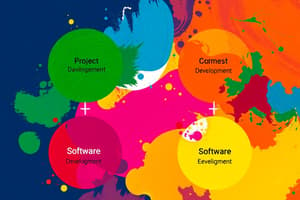Podcast
Questions and Answers
In a scenario where project requirements are likely to change significantly throughout the development lifecycle, which software development model would be most appropriate?
In a scenario where project requirements are likely to change significantly throughout the development lifecycle, which software development model would be most appropriate?
- V-Model
- Spiral Model
- Waterfall Model
- Agile Model (correct)
Which of the following is a key consideration for system architecture related to ensuring continuous service availability even in the event of component failure?
Which of the following is a key consideration for system architecture related to ensuring continuous service availability even in the event of component failure?
- Scalability
- Performance Optimization
- High Availability (correct)
- Authentication
An organization wants to integrate several independent applications to work together by using a central point of communication. What integration strategy is most suitable?
An organization wants to integrate several independent applications to work together by using a central point of communication. What integration strategy is most suitable?
- Enterprise Service Bus (ESB) (correct)
- Point-to-Point (P2P)
- Event-Driven Architecture (EDA)
- API-First Approach
When deciding to use containerization over virtualization, what is the primary advantage one should consider?
When deciding to use containerization over virtualization, what is the primary advantage one should consider?
Which type of requirement defines how well a system performs, including aspects like speed, reliability, and scalability?
Which type of requirement defines how well a system performs, including aspects like speed, reliability, and scalability?
A project team needs to gather detailed requirements from a diverse group of stakeholders with potentially conflicting opinions. Which requirements gathering technique would be most effective to facilitate a collaborative discussion and reach a consensus?
A project team needs to gather detailed requirements from a diverse group of stakeholders with potentially conflicting opinions. Which requirements gathering technique would be most effective to facilitate a collaborative discussion and reach a consensus?
What is the primary goal of a feasibility study in the requirements engineering process?
What is the primary goal of a feasibility study in the requirements engineering process?
Which requirements prioritization method involves categorizing requirements into 'Must-have', 'Should-have', 'Could-have', and 'Won't-have' categories?
Which requirements prioritization method involves categorizing requirements into 'Must-have', 'Should-have', 'Could-have', and 'Won't-have' categories?
An architect is designing a system where the user interface, application logic, and data storage are separated into distinct components. Which architectural pattern is being implemented?
An architect is designing a system where the user interface, application logic, and data storage are separated into distinct components. Which architectural pattern is being implemented?
What security practice involves verifying the identity of a user or device and then determining what resources they are permitted to access?
What security practice involves verifying the identity of a user or device and then determining what resources they are permitted to access?
Flashcards
SDLC phases
SDLC phases
Planning, Analysis, Design, Implementation, Testing, Deployment, Maintenance
Agile Model
Agile Model
Iterative, flexible, continuous feedback, customer collaboration
Spiral Model
Spiral Model
Risk-driven, iterative, best for large projects with evolving requirements
V-Model
V-Model
Signup and view all the flashcards
DevOps (CI/CD)
DevOps (CI/CD)
Signup and view all the flashcards
Cloud Computing Models
Cloud Computing Models
Signup and view all the flashcards
Functional Requirements
Functional Requirements
Signup and view all the flashcards
Non-Functional Requirements
Non-Functional Requirements
Signup and view all the flashcards
Requirements Validation
Requirements Validation
Signup and view all the flashcards
Requirements Management
Requirements Management
Signup and view all the flashcards
Study Notes
Advanced Systems Development Principles
- Software development follows specific models to streamline the process
Software Development Models
- Software Development Life Cycle (SDLC) phases include Planning, Analysis, Design, Implementation, Testing, Deployment, and Maintenance
- The Waterfall model is best for well-defined projects due to its linear and rigid structure
- The Agile model is iterative, flexible, provides continuous feedback, and encourages customer collaboration
- The Spiral model is risk-driven, iterative, and suitable for large projects with evolving requirements
- The V-Model focuses on validation and verification at each phase for structured projects
- DevOps (CI/CD) enables Continuous Integration & Continuous Deployment for automation and faster releases
System Architecture and Integration
- Principles of System Architecture include Scalability, High Availability, Fault Tolerance, and Performance Optimization
- Security best practices include Authentication, Encryption, Access Control, and Multi-Factor Authentication (MFA)
- Point-to-Point (P2P) integration involves a direct system-to-system connection
- Enterprise Service Bus (ESB) is a centralized integration hub for multiple applications
- Event-Driven Architecture (EDA) allows Asynchronous communication for real-time processing
- The API-First Approach uses RESTful API-based integration for flexibility
- ETL (Extract, Transform, Load) is used for large-scale data integration and analytics
System Deployment and Cloud Computing
- Containerization (Docker) differs from Virtualization (Virtual Machines or VMs)
- Infrastructure as Code (IaC) automates deployment using Terraform and AWS CloudFormation
- Cloud Computing Models include Public, Private, and Hybrid Cloud options
- Performance Optimization Strategies involve Load Balancing, Database Replication, and Caching
Requirements Analysis and Engineering
- It focuses on identifying and defining what a system should do and how it should perform
Types of Requirements
- Functional Requirements define what the system should do, such as user authentication, reporting, and transactions
- Non-Functional Requirements define how the system should perform, including aspects like security, scalability, and usability
- Technical Requirements cover infrastructure, database, and software dependencies
- Business Requirements are linked to the business goals that guide system development
- Regulatory & Compliance Requirements adhere to industry standards, security policies, and legal constraints
Requirements Gathering Techniques
- Interviews involve one-on-one discussions with stakeholders
- Surveys & Questionnaires collect structured responses from users
- Observation involves watching users interact with existing systems
- Document Analysis includes reviewing existing system documents and reports
- Prototyping involves building a functional model for early user feedback
- Focus Group Discussions (FGD) engage stakeholders to discuss system needs
Requirements Engineering Process
- A Feasibility Study assesses if the project is technically, operationally, and economically viable
- Requirements Elicitation involves gathering system requirements from stakeholders
- Requirements Specification documents requirements in a structured format (e.g., Software Requirements Specification - SRS)
- Requirements Validation ensures accuracy, completeness, and consistency of requirements
- Requirements Management focuses on tracking and controlling changes to requirements throughout the project
Requirements Prioritization Methods
- MOSCOW Method categorizes requirements as Must-have, Should-have, Could-have, and Won't-have
- The Kano Model categorizes basic, performance, and exciting requirements
- Cost-Benefit Analysis evaluates feasibility based on cost vs. value
Challenges in Requirements Engineering
- Ambiguous Requirements arise from unclear expectations from stakeholders
- Conflicting Stakeholder Needs involve balancing different business and user priorities
- Evolving Requirements involve handling changes during development without project delays
- Overlooking Non-Functional Requirements involves ensuring security, performance, and usability are defined
Architectural Modeling and Design
- It involves creating models and patterns to design software architecture
System Modeling Techniques
- Structural Models use class diagrams and component diagrams
- Behavioral Models use case diagrams and sequence diagrams
- Functional Models use data flow diagrams (DFDs)
- Data Models use Entity-Relationship Diagrams (ERDS)
- Physical Models use deployment diagrams and network topology diagrams
Software Architecture Patterns
- Layered Architecture organizes software into Presentation, Business Logic, and Data layers
- Client-Server Architecture separates the frontend (client) from the backend (server)
- Microservices Architecture uses independent, modular services that communicate via APIs
- Event-Driven Architecture (EDA) enables asynchronous, event-based message processing
- Model-View-Controller (MVC) separates UI, logic, and data handling
- Master-Slave Architecture has a master system controlling multiple slaves for parallel processing
High-Level System Design Principles
- System Architecture Planning involves designing system components and their interactions
- Data Flow Diagrams (DFDs) visualize data movement across the system
- Interface Design defines APIs and system interactions
- Technology Stack Selection involves choosing programming languages, frameworks, and databases
- Deployment Architecture includes cloud hosting, on-premises servers, and hybrid models
Security and Performance Considerations in Architecture
- Authentication & Authorization involves Multi-Factor Authentication (MFA) and Role-Based Access Control (RBAC)
- Encryption Mechanisms use secure communication using TLS, SSL, and database encryption
- Logging and Monitoring tracks system activities for security and auditing
- Load Balancing & Database Replication involves distributing traffic and maintaining data redundancy
Studying That Suits You
Use AI to generate personalized quizzes and flashcards to suit your learning preferences.




